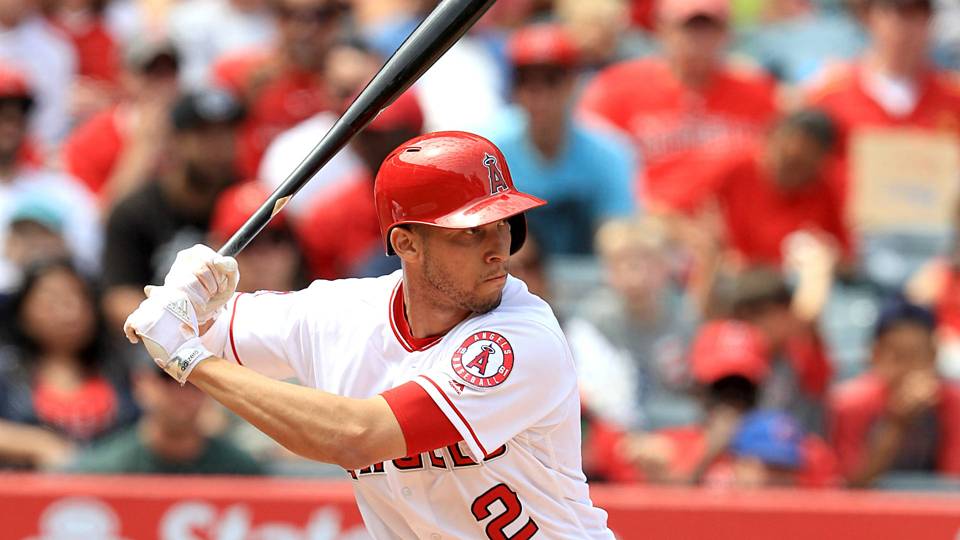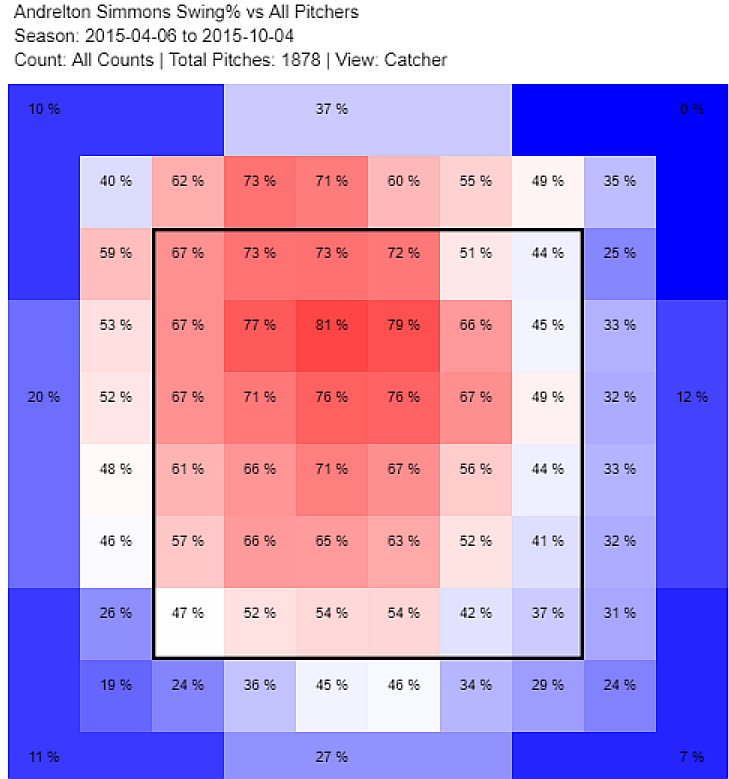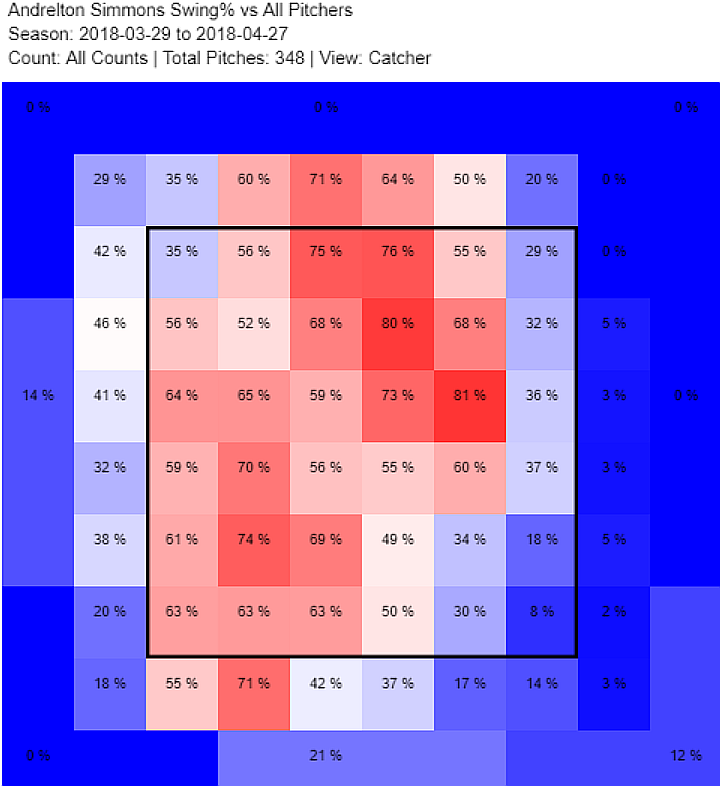By Greg Bird, AngelsWin.com Staff Reporter
Welcome back to Inside Edge after a very long hiatus. First I’d like to thank Chuck for pulling me back in to writing for AngelsWin after a long stint on the DL. I’d also like to thank Billy Eppler for giving an Angel fan hope again. This is not to say I didn’t like the person that was our former GM, he was a ‘good dude’ but his moves just lacked the true inspiration of Eppler’s. With my first short article this Greg Bird returns from the DL for the Halos (not the evil empire) and he will be focusing on a recent hot topic, Andrelton Simmons the hitter.
There has been a flurry of recent articles about Simmons’ and his countryman Gregorius’ turn arounds at the plate. In the Athletic Simba’s general improvements at the plate were covered in depth. I suggest a subscription there for some good content. Another good piece I saw was in The Ringer and it talked a lot about both Simmons’ and Gregorius’ increase in patience. In that second article there was a very intriguing quote from Simmons about a text he received from Eppler about, “how good I am when … I’m actually swinging at pitches I’m good at hitting.”
This quote got me wondering about what that text was all about and if the numbers bear out that he actually made a change in his swing pattern as suggested by Eppler. If Simmons did make a real positive change then it could mean this new above average hitter is our new normal for him through 2020 and beyond. This would also mean that we can trust that whatever happens with personnel moves in the future that Eppler has an even better process as a GM than previously thought.
Eppler traded for Simba in 2015. At that time it was common knowledge that Simmons was a light hitting but superb fielding shortstop. As others have mentioned and multiple sources reported at the time he was also a good contact hitter.
Andrelton swung at a lot of pitches that lead to more outs earlier in his career. His swing percentage hovered around the 47% mark earlier in his career. It is down around 45% now. Being able to make consistent contact and with umpires calling borderline strikes it likely encouraged him to swing at more borderline pitches. These were pitches that he just couldn’t really do much with. His underlying excellent ball to bat skill also likely played a part in his continuing to swing at those pitches even though it was not producing the results he wanted.
Simmons career contact percentage is 87.9%. This has remained relatively unchanged throughout his entire career with a fluctuation in 2015. That year it jumped to 89.3% which did result in a temporary increase in BABIP and Batting Average but it has been an unsustainable increase. That year he also showed very little power with a .660 OPS, the second lowest of his career. Simmons contact rate has fallen back in line with his career norms in the high 87% range and is not now the cause of his great renaissance.
What has changed? Do the numbers show anything different? According to Simmons he has changed which pitches he swings at now. That would mean he has fundamentally changed his approach at the plate. Can we see that in the data? Let’s look at two heat maps that tell us what percentage of pitches in each zone that Simmons is swinging at or has swung at in the past.
Let’s start with his approach in 2015, the last full year before he joined the Angels. We can see that on pitches just outside of the strike zone he would swing at about 33% of them. He would do this on both the high and low pitch. These pitches are sometimes called a strike and I’m sure he felt he had to protect the plate. He would swing at pitches down and away at right around the same percentage of the time, anywhere from 29%-37% of the time. He swung at pitches in the furthest outside part of the strike zone at a 49% clip. And he also swung at pitches just inside at a 48%-53% rate.
I point those out because those are the areas both in and out of the zone that Simba has seemingly changed the most. If we now compare his 2015 swing percentage to his 2018 heat map we can see exactly how much he changed his approach. This season he has only swung at about 5% of pitches just outside the zone. He is currently only swinging at 9%-18% of down and away pitches both in and out of the zone. He is only offering at 33%-38% of pitches in the outside part of the zone. And he is only swinging at around 35% of pitches on the inside part of the plate.
These are significant changes of between 15%-25% in his swinging percentage. It then seems that Eppler convinced Simmons in that text that pitches just inside or just outside the zone were not pitches that he could handle well. He probably told Simmons that he could reach them and make contact but not really be successful on that contact. It also looks like pitches in the zone but away or down and away were not his strong suite either.
He likely did this by showing him what he should hit, and not just what he shouldn’t. Let’s look at what Simba does hit well.
If we go back and look at his average on different parts of the zone we will start to see what Simmons does handle well. On pitches down and away he is batting a measly .214. On outside pitches he is batting between .159 and .190. And finally on down and in pitches he is hitting .200. These are the pitches he is not swinging at. In most other zones he is hitting .275 or better with up and in strikes being his hottest zone at a scorching .417.
If we look even deeper at his exit velocities we see his weakest contact comes outside down and away at a paltry 77.5 MPH. His lowest exit velocity in the zone is down and away again at 81.1 MPH. While his hottest zones (middle-middle, middle-up, middle-away, and up-away) all hovering around 90 MPH. This likely the zones Eppler suggested he focus on trying to hit.
What we can see from all of this is a concerted effort from Andrelton to change which pitch he offers at. He now seems to be hunting pitches he can do damage with and letting go pitches he really can’t do much with, even if it means letting the umpire call it a strike. This type of change in his approach seems eminently sustainable. It seems his newfound success is predicated on both pitch recognition and better decision making, two things that bode well for his future as a hitter.
Add The Sports Daily to your Google News Feed!



